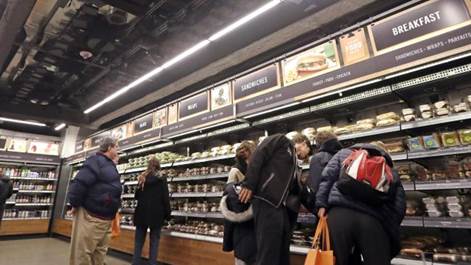WILL PAVIA
January 23, 2018
The Times
A supermarket with no checkout tills opened in Seattle yesterday morning, offering customers groceries, ready-meals and the vague feeling that they were shoplifting.
The truth was far more unsettling. The supermarket was watching them. They were stepping into Amazon’s new realm, Amazon Go: a shop that registered their every move via a dense network of cameras and sensors, recording everything they placed in their bag and charging them automatically after they stepped out onto the pavement.
Billed as the most technologically advanced grocery store in the world, Amazon has declined to offer details of how its artificially intelligent supermarket may be deployed beyond Seattle. But the company registered the store’s trademark — “No queue. No check out. (No, seriously)” – in Britain last spring, shortly before purchasing the supermarket chain Whole Foods, which has seven shops in London, for $14 billion.
The Amazon Go store in Seattle opened to the company’s employees in December 2016. A planned opening to the general public was delayed last year — The Wall Street Journal reported that the system was struggling to cope with more than 20 shoppers at a time and to keep track of goods that customers put back in the wrong place.
Yesterday the shop began tracking new customers, who registered their arrival using a smart phone app at the entrance as they passed through a series of gates akin to those at an airport.
From there banks of cameras on the ceiling and a network of sensors tracked individual customers through the shop. Amazon has said it does not use facial recognition technology — instead it relies on the same “computer vision” that allows self-driving cars to recognise pedestrians moving down a pavement or crossing the road.
It says this vision is combined with “sensor fusion”, in which data from a number of different sensors is combined to produce a fuller picture, and “deep learning algorithms” that ensure the supermarket gets slightly smarter with each new shopper. The computers can “see” both the customers and the items they reach for, as well as anything a customer puts back on the shelf.
The system raises obvious concerns for the 3.5 million people who worked as cashiers in America in 2016, but Amazon Go does employ staff to help customers find items, to restock shelves and to check that the people putting beer and wine in their bags are over the legal drinking age.
Minutes after customers leave, they receive an electronic receipt, indicating they have been charged on their Amazon account for what the supermarket knows they had taken.
Ryan Calo, a professor of robotics law and policy at the University of Washington, said the system raised privacy and security concerns, although it could also remove the stigma of purchasing condoms. It will also allow Amazon to tweak its store based on minute observations of customers’ behaviour, he said.
No longer would shoppers face chocolate and magazines at the till. “But they will do the same thing in a much more effective way,” he said. “Think of what a casino does. Casinos study customers in the form of gamblers: what’s going to keep them there the longest? How are we going to design it? Grocery stores are going to become casinos.”
Subscribe to our free mailing list and always be the first to receive the latest news and updates.

